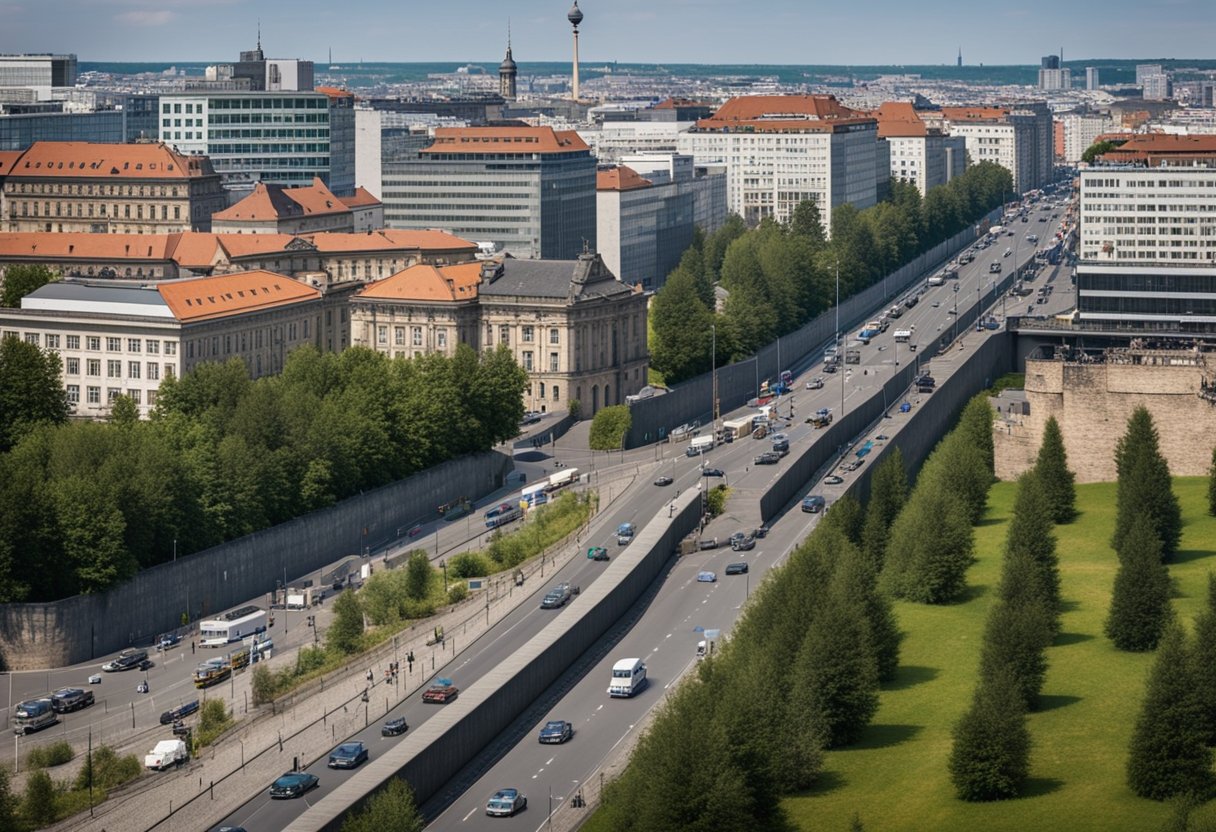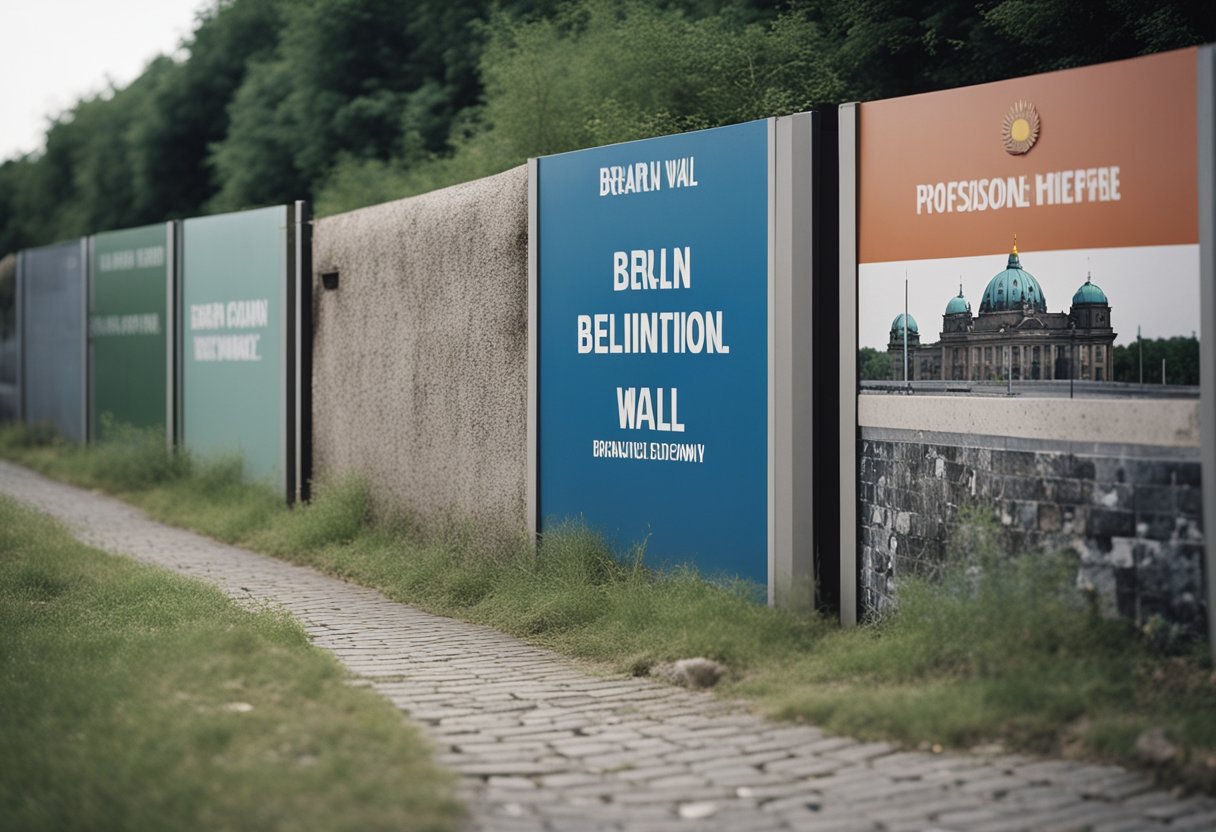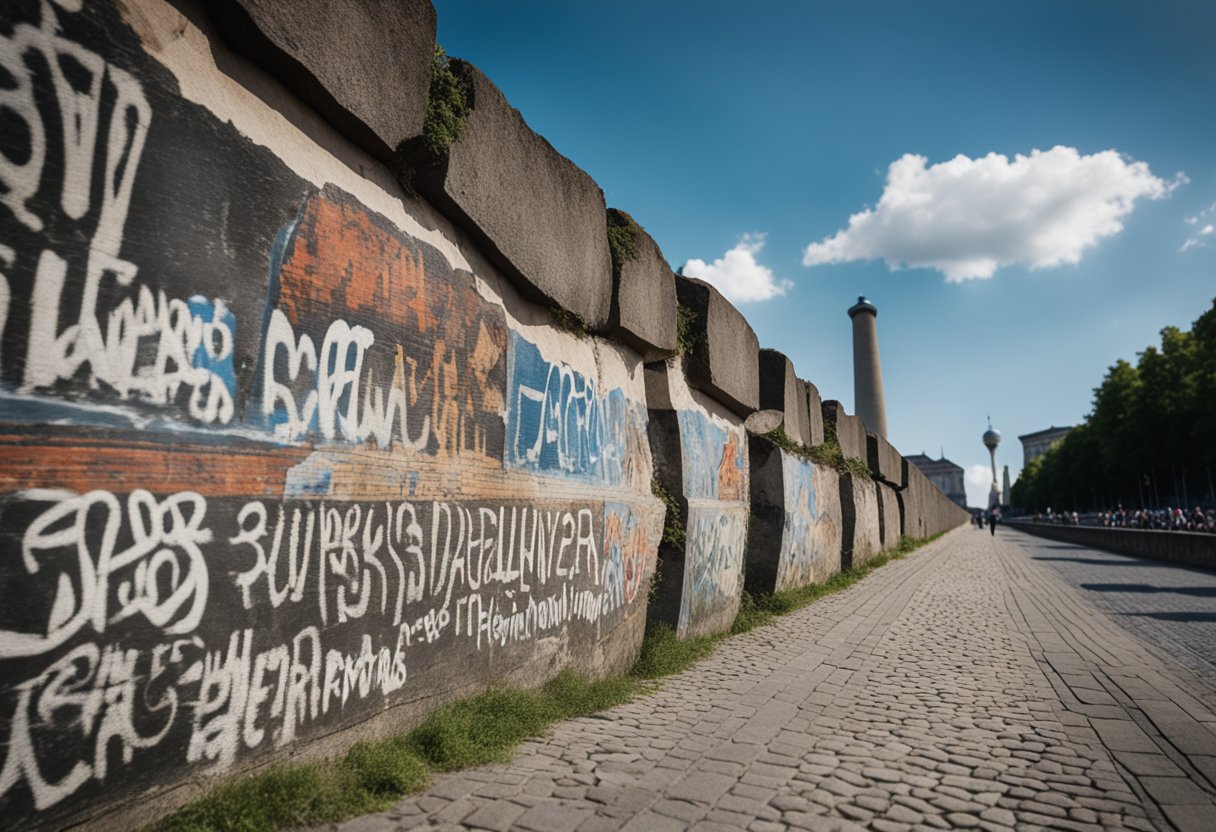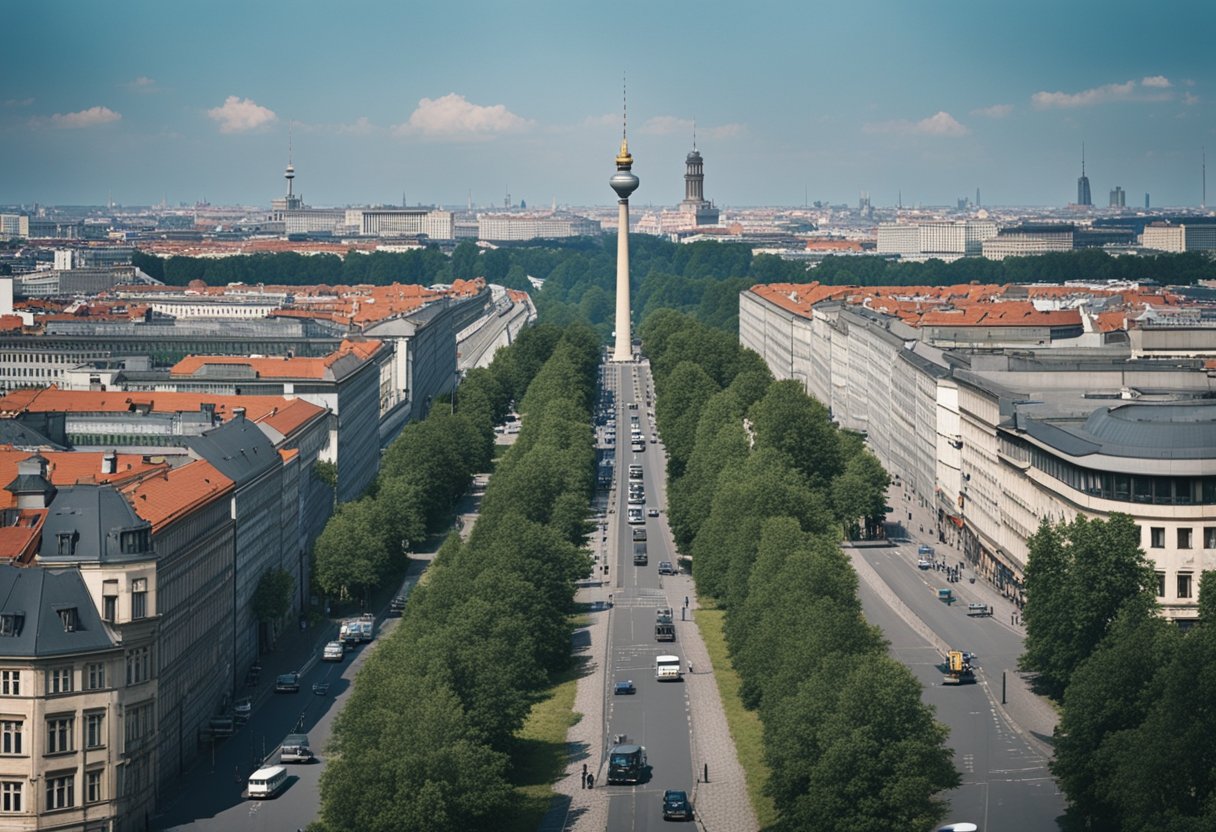The Berlin Wall stood as a physical division between East and West Germany from 1961 until its fall in 1989, embodying the broader divide of the Cold War era. The construction of Berlin Wall’s Economic Impact on East and West Germany , effectively splitting a once unified economic landscape into two disparate systems.
West Germany, bolstering a social market economy, flourished under the influence of Western Allies and developed into one of the world’s strongest economies. In contrast, East Germany, operating under a Soviet-style planned economy, lagged in economic development, suffering from inefficiencies and a lack of investment.

During its existence, the Berlin Wall represented not only a divide in political ideologies but also an economic barrier that hindered trade and the free movement of labor.
East Germany faced significant emigration to the West prior to the Wall’s erection, losing skilled workers and creating a brain drain that affected various sectors of its economy. The Wall’s presence exacerbated this issue, as it became a literal barrier to economic opportunity and a symbolic reminder of the division between the socialist East and the capitalist West.
After the Fall of the Berlin Wall, Germany embarked on an ambitious and costly reunification process. The integration of the two economic systems presented challenges, as the West extended substantial financial aid to the East to uplift its infrastructure, industry, and standard of living.
This economic alignment aimed to erase the disparities exacerbated by the Wall and restore a unified German economy capable of continuing its role as a significant player on the international stage.
Historical Context and Background-Berlin Wall’s Economic Impact on East and West Germany

The Berlin Wall stands as a defining symbol of the economic bifurcation that occurred in post-World War II Germany. Erected in 1961 and dismantled in 1989, its presence shaped not just the social and political landscapes, but also had profound economic implications for both East and West Germany.
Rise of the Berlin Wall
East Germany, officially known as the German Democratic Republic (GDR), constructed the Berlin Wall in response to the mass emigration of its citizens to West Berlin.
Initially composed of barbed wire and later reinforced with concrete walls, watchtowers, and a perilous death strip, it aimed to curtail the brain drain of skilled workers that threatened the state’s economic viability.
Division of Germany: Impacts on East and West
Within the divided lands, West Germany, supported economically by the Western Allies including the United States, France, and the United Kingdom, experienced a ‘Wirtschaftswunder’ or economic miracle, fostering a robust market-driven economy.
Conversely, East Germany, under the strict control of the Socialist Unity Party and aligned with the Soviet Bloc, faced economic stagnation due to its centralized planning and lack of access to global markets.
Global Political Climate During the Cold War
The period was marked by a tense stand-off between the NATO countries and the Warsaw Pact, of which the Soviet-controlled East Germany was a part. This global divide, known as the Iron Curtain, extended into Germany, heavily influencing its economic policies and outcomes.
The Berlin Airlift, Checkpoint Charlie, and the Brandenburg Gate became symbols of this struggle, with West Berlin becoming an island of capitalism in a sea of communism.
Economic Impact on East and West Germany

The erection and subsequent fall of the Berlin Wall had far-reaching economic impacts on both East and West Germany, significantly transforming economic policies, labor demographics, and infrastructure development between the two regions.
Economic Policies and Growth
East Germany, officially known as the GDR (German Democratic Republic), operated under a communist economy with centralized planning and state ownership of production. After the Berlin Wall came down, the integration of East Germany into the capitalistic framework of West Germany required substantial economic restructuring.
The transition led to a turbulent period where the East struggled to achieve the same economic viability as the West. Concerns over wages, privatisation of assets, and the introduction of market-oriented policies marked significant changes for East German citizens who were adapting to a new economic system.
In the West, economic growth had been robust, and financial support from taxpayers was crucial in underpinning the costs of unification. Linking the economically divergent systems posed challenges, but the West’s established capitalism laid a foundation for the economic security of a unified Germany.
Brain Drain and Its Consequences
The presence of the Berlin Wall led to a brain drain, where a significant number of skilled workers from East Germany migrated to the West in search of better opportunities, freedom, and quality of life.
This movement of talent had substantial consequences on the labor market and economic output of the GDR, weakening its workforces in vital industries and scientific research. The fall of the Wall saw a continuation and even acceleration of this trend, compounding the challenges faced by the East German economy as it transitioned to a market-based system.
Infrastructure and Financial Support Differences
The discrepancy in infrastructure quality between East and West Germany was pronounced. The West received more financial support for development over time, which manifested in advanced transportation networks, communication systems, and public services. East Germany had fallen behind due to insufficient investment and the economic policies of the communist regime, contributing to the stark contrast.
Post-reunification efforts saw immense financial transfers from West to East with the objective to align the infrastructure and living conditions across Germany. These investments were critical in creating a balanced, economically unified country, yet they represented a significant burden on the resources of West German taxpayers.
The economic landscape of Germany, as shaped by the Berlin Wall and its aftermath, is a complex tale of two systems merging into one, with the end goal of establishing equilibrium and prosperity across the newly unified nation.
The Fall of the Berlin Wall and its Immediate Economic Effects

The abrupt dismantling of the Berlin Wall triggered significant political changes and immediate economic effects, altering the economic landscape of both East and West Germany.
GDR’s Political Changes Leading to the Fall
The rapid political changes within the German Democratic Republic (GDR) were pivotal to the fall of the Berlin Wall. Under mounting pressure, the GDR’s leadership, including figures like Egon Krenz, struggled to maintain the status quo in the face of calls for reform.
Public demonstrations in cities like Leipzig and Alexanderplatz drew inspiration from liberalizing efforts elsewhere, including Hungary and Czechoslovakia, and the profound influence of Mikhail Gorbachev’s policy of Glasnost and Perestroika. The era’s political ferment, intensified by Günter Schabowski’s accidental announcement, facilitated the unexpected opening of the border.
Border Opening and Currency Conversion
The immediate aftermath of the Wall’s fall commenced on November 9, 1989, when border guard Harald Jäger allowed the first East Germans to cross into West Berlin. This historic decision led to the excavation of the physical barrier and the collection of cobblestones by euphoric crowds.
Economically, one fundamental challenge was the currency conversion, as the Deutsche Mark became the strong currency sought by East Germans. The sudden accessibility to western goods placed immense strain on the East’s economy, leading to widespread disruption and an urgent need for financial stability measures.
German Reunification and Long-Term Economic Changes

The fall of the Berlin Wall paved the way for the reunification of Germany, which significantly altered the country’s economic landscape. This transition presented both hurdles and prospects for integrating East and West Germany’s economies.
Integration Challenges and Opportunities
Integration Challenges:
- Economic disparities: At the time of reunification, East Germany’s economy was considerably less developed than that of West Germany. Closing this gap required significant investment and modernization efforts.
- Productivity and industry modernization: East German industries often operated with outdated technologies and needed significant upgrades to compete in the market economy.
- These challenges are highlighted in the examination of the economic aftermath on East Germany.
Opportunities:
- Market expansion: Unification opened new markets, leading to opportunities for businesses and investors.
- Labor force integration: Reunification combined the workforce of both regions, providing opportunities to optimize labor resources across Germany.
Labor Market and Migration Trends
Labor Market:
- The transition to a market economy in East Germany led to substantial job losses in the short term as East German companies struggled to adapt. However, over time, the labor markets began to stabilize and adapt to the competitive environment.
- Migration from East to West: The fall of the Berlin Wall and subsequent reunification triggered a considerable migration from East to West Germany, as individuals sought better employment and living conditions. The migratory trends underscored the demand for policy measures to balance labor demand and supply.
Migration Trends:
- After the opening of the Berlin Wall, there was a significant migration of skilled workers and young people from East to West Germany, leading to a drain of talent in the East. This migration rate was estimated at about 2,000 people per day at its peak, which can be seen in this historical perspective.
- Over time, this exodus contributed to labor market imbalances that required strategic policy interventions to ensure equitable development across unified Germany.
Social and Economic Aftermath For Berliners

The fall of the Berlin Wall marked the beginning of significant social and economic changes for Berliners, with immediate improvements in living standards and shifts in employment due to newfound freedoms.
Changes in Living Standards
With the Berlin Wall’s demise, East Germany saw a notable increase in living standards. GDR citizens previously hindered by limited access to western goods and a lagging economy embraced the material benefits of a reunified Germany.
Consumer goods, previously scarce or of inferior quality in the East, flooded the market. Essential products like cars and electronics were now available, significantly improving the quality of life for many Berliners.
Freedom of Movement and Employment Shifts
Moreover, the abrupt removal of physical and ideological confines allowed for unprecedented freedom of movement for former East German citizens. Mass demonstrations had expressed a deep desire for democracy and the ability to travel; these demands were swiftly realized post-Wall. Access to the West created opportunities for employment in a broader range of professions, fostering notable migration.
However, this newfound freedom also led to a brain drain as skilled workers, including professionals and those with independent journalism aspirations, sought better prospects outside the former East Germany. As a result, the dynamics of the job market endured significant transformation, both promoting new opportunities and introducing challenges, like job competition and regional depopulation.
Global Repercussions of the Berlin Wall’s Influence on Germany’s Economy
The fall of the Berlin Wall had significant economic impacts, not only for Germany but for the global economy, influencing international relations, trade dynamics, and reshaping the role of Germany in post-Cold War Europe.
International Relations and Trade Dynamics
The Berlin Wall’s presence and subsequent demolition marked periods of tension and transformation in global economic alliances. Prior to its fall, West Germany, thriving under a social market economy, was integrated into the European Economic Community.
Conversely, East Germany fell under the Warsaw Pact, led economically and politically by the Soviet Union. The fall of the wall led to the dissolution of the Warsaw Pact and German reunification, which triggered shifts in international trade agreements and alignments.
The integration of East German states into the Federal Republic of Germany allowed for the expansion of trade ties with NATO countries, fundamentally boosting trade dynamics and relations with nations including the United States, France, and others aligned or previously divided during the Cold War era.
Germany’s Role in a Post-Cold War Europe
Post-reunification saw Germany take a more pivotal role within Europe as it became a unified economic front. German policymakers, influenced by key figures like Chancellor Willy Brandt and global leaders such as US President Ronald Reagan, navigated through the complexities of merging two distinct economic systems.
This led to increased economic clout within the reformed European Economic Community, which later evolved into the European Union.
The robust German economy, bolstered by the unification, reinforced its status as a central force in Europe’s economic framework and aided in stabilizing the economies of post-communist European states transitioning away from centrally planned economies, sealing Germany’s critical role in the shaping of the European economy post-Cold War.
Cultural and Psychological Impact on Economic Behavior
The fall of the Berlin Wall not only reconfigured geopolitical landscapes but also profoundly influenced the economic behavior of Germans, reshaping consumer sentiment and invigorating the entrepreneurial spirit in the nation.
Consumer Sentiment and Investment Trends
The dismantling of the Berlin Wall on November 9, 1989, signaled the end of the physical and ideological division between East and West Berlin. The newfound freedom of movement led to a wave of optimism that swept through the population, resulting in significant changes in consumer sentiment.
In the years following German reunification, this positive outlook propelled consumer spending and investment trends, with people from both sides of the former divide eager to participate in the unified economy.
The Entrepreneurial Spirit in Post-Wall Berlin
As new policies took root post-reunification, East Berlin and the larger East German region experienced a surge in entrepreneurial activities. Limited by the death strip that stood as a reminder of restriction, the citizens of East Germany were quick to embrace the cultural shift towards a market-oriented economy.
The area around the iconic Brandenburg Gate, once a symbol of division, became a focal point for economic development and symbolized the new potential for commerce and innovation in a reunified Germany.
This entrepreneurial spirit was further fueled by mass demonstrations that had previously advocated for systemic change and encouraged a culture of self-sufficiency and economic exploration.
Frequently Asked Questions
The Berlin Wall not only divided the city and its people but also had a profound impact on the economy of both East and West Germany. This section addresses the specific economic aspects influenced by the wall’s presence and its eventual fall.
What were the economic impacts of the Berlin Wall on East and West Germany?
The economic effects of the Berlin Wall were significantly contrasting for East and West Germany. While West Germany developed into a thriving, market-based economy, East Germany struggled under a planned economy, resulting in lower living standards and productivity rates. The economic impacts included restricted trade and a lack of consumer goods in East Germany.
How did the division of Berlin impact the city’s business and commerce?
The division of Berlin led to severed trade connections that once benefited the city’s collective commerce. West Berlin became an economic exclave, heavily subsidized by West Germany, while East Berlin faced a shortage of goods and depended on the Soviet bloc’s economic system.
What were the long-term economic consequences for Germany after the fall of the Berlin Wall?
Following the fall of the Berlin Wall, Germany faced the challenge of economic integration. The Treuhand privatized East German state-owned enterprises, leading to mass unemployment but ultimately reducing the income disparity between the east and the west in the long run.
In what ways did the Berlin Wall contribute to the environmental issues in Germany?
The Berlin Wall’s presence contributed to different environmental policies being enacted in East and West Germany. East Germany faced significant pollution due to the industrial focus of its planned economy and less stringent environmental regulations.
How did the political separation caused by the Berlin Wall influence the economic strategies in East and West Germany?
Economic strategies were distinctly shaped by the ideologies of each side; East Germany implemented state-controlled central planning, while West Germany adopted a social market economy. This separation led to a stark contrast in economic vitality and consumer availability between the two sides.
How was the Economic reconstruction of Germany influenced post-World War II with the establishment of the Berlin Wall?
The establishment of the Berlin Wall halted the economic progress achieved in the post-WWII reconstruction era by creating a physical and ideological barrier that partitioned German resources and labor markets. It anchored the division of economic systems and recovery strategies between the two Germanys.